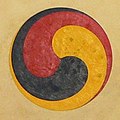KOREAN
FAREWELL
Today
we said goodbye again
this
time to three, two angels
and
a storm. One angel is a
mediator—mild
and gentle,
sun
on a freezing day, rain
for
parched souls. She lives
with
the storm, good of heart,
yet
ever raging to control,
ever
trying to drive out flaws.
Together
they are balanced.
My
dear sister-friend another
angel
said goodbye too—off
for
a new adventure, for another
life.
A hole burns in my heart.
I
have lost a piece of me.
Today
the heavens wept.
The
rainy season started
on
time this year. Is the
divine
controller weeping too?
The
highway was clogged
a
truck tried to visit the
riverside
garden by breaking
through
a guardrail. The
driver
was hurt, the truck
split.
It took two hours to
drive
fifteen miles.
We
drivers wept.
I
contemplated my loss
as
I sat and waited.
I
wept.
Later,
going sixty miles an hour
I
saw a stainless steel kitchen sink
right
in the middle of the ‘spressway.
I
laughed. I must be in Korea.

"Taeguk" is the Korean form of the Chinese "Taiji" (supreme ultimate, great pole) and but is used primarily to mean the tijitsu symbol that people commonly associate with the yin and yang. It is prominently displayed on the Korean national flag, designed in the 1880s but has been used throughout Korean written history. In Joseon, the kingdom that was founded in 1392 and lasted until 1905, when Japan imposed protectorate status, it represented local Daoism and Mugyo, the country's shamanistic religion. In addition to the usual interlocking red and blue semicircles, symbolizing earth and heaven, a yellow lobe representing humanity is sometimes added; this symbol was adopted by the Miss Asia Pacific World Beauty Pageant,
ReplyDeletewhich was hosted in Seoul from its inception in 2011 until 2014, and as part of the official logo of the 1988 Olympics in Seoul; the detached spiral components were also used as the basis for the logo for the 1988 Paralympics, held in parallel with the Olympics for the first time that year.